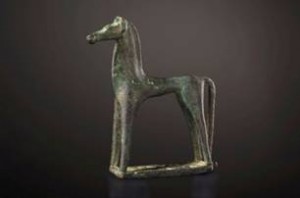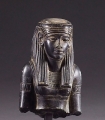Rarities on the stand of Phoenix Ancient Art include:
Emperor Antoninus Pius (138-161 A.D.) [detail]
Bronze Roman, second half of the 2nd century A.D. Preserved H: 115 cm. (45.3 in.)
The statue is in a remarkable state of preservation, despite its loss of the arms and legs. Parts of it have a beautiful light bluish-green patina, while the rest retains the dark brown coloring of the original bronze. Unlike many ancient statues, this one is fully modeled on all sides. The figure is a larger-than-life size male adult shown in heroic nudity. The presence of several small holes on the top of the head, as well as the remains of lead on the hair above the forehead, suggests that the figure once wore a crown. The head of the statue is clearly a portrait, presumably one of an emperor, Antoninus Pius, and the sculpture was most likely made during his 23 year reign. Under his rule the Roman Empire enjoyed peace and prosperity. Antoninus Pius is one of the so called “Five Good Emperors” : the others were Nerva, Trajan, Hadrian, who preceded him, and Marcus Aurelius, who succeeded him..
![Emperor Antoninus Pius (138-161 A.D.) [detail]](http://www.antiquitiesworld.net/wp-content/uploads/2010/10/SC14150-42-234x300.jpg)

